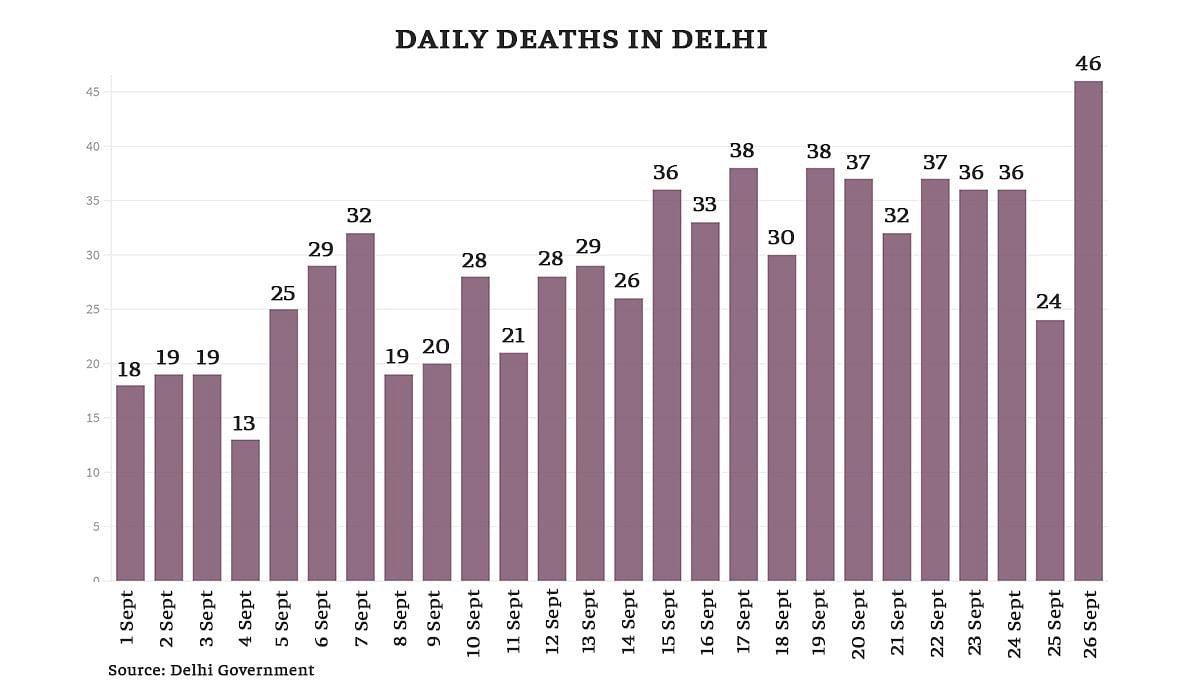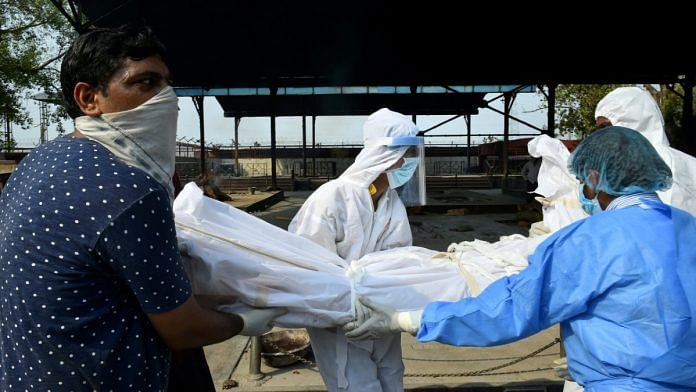New Delhi: The daily death toll in Delhi due to Covid-19 has more than doubled this month — from 18 deaths on 1 September to 42 on 27 September. There were 46 deaths Saturday, the highest in past 72 days.
As of 26 September, Delhi’s case fatality rate is 1.9 per cent, against the national average of 1.6 per cent. This, despite daily cases in the capital showing a declining trend in the past month.
Doctors ThePrint spoke to said the increase in deaths is due to a higher number of elderly persons and those with comorbidities getting infected. The doctors also said serious patients are coming in from neighbouring states, which is reflecting in Delhi’s numbers.
On Thursday, Chief Minister Arvind Kejriwal said Delhi appears to have passed the second peak, with daily cases showing a steady decline.
As of 27 September, Delhi recorded a total of 27,11,14 cases with 5,235 deaths and 23,66,51 recoveries.
Also read: Only 37% ventilator beds vacant in Delhi, private hospitals say can’t reserve more ICU beds
Daily toll on the rise
Delhi government data analysed by ThePrint reveals that the national capital’s death toll Saturday (46) was the highest in 72 days. The last time the death toll was this high was on 16 July when 58 deaths were recorded.
Through the month of September, the death toll has more than doubled in the capital. In the last week alone, deaths increased from 38 on 19 September to 46 on 26 September (see graph).

Delhi also recorded the eighth highest death toll in the country Saturday. The Ministry of Health and Family Welfare said of the 1,124 deaths in the last 24 hours, 84 per cent of deaths in the country were from only 10 states and UTs, which includes Delhi at the eighth position.
The Delhi government, on the other hand, told ThePrint that the spike in deaths should not be looked at in isolation. “Deaths will increase with the increase in cases. Through September, there has been a spike in cases. The death figure (46) for Saturday cannot be looked at in isolation,” said Dr Nutan Mundeja, the Delhi Director General Health Services. “Deaths have been fluctuating between 25 and 35 through the month. The figure 46 is for carried over cases from the past few days.”
What makes the rising death toll worrisome is because daily cases have seen a dip in the past week after a spike since August. Daily cases decreased from 4,071 cases on 19 September to 3,292 on 26 September.
‘Higher number of cases among elderly, those with comorbidities’
The doctors that ThePrint spoke to said the rise in deaths reflects the higher number of people with comorbidities or the elderly who are getting infected despite the dip in cases.
“More people in the vulnerable age group i.e. the elderly with comorbidities are getting infected and that is reflecting in the deaths,” said Dr B.L. Sherwal, director at the Delhi government-run Rajiv Gandhi Superspeciality Hospital. “In addition, we are also getting a high volume of sick patients from neighbouring states who are coming to Delhi for treatment, especially in private hospitals.”
With the easing of lockdown measures, the doctors added, critical patients are coming for treatment from other states. “It’s not just that patients are coming from other states, but very critical patients are coming, which is reflecting in the deaths (data),” said Dr S. Chatterjee, internal medicine specialist, Indraprastha Apollo.
The doctors also said the increase in deaths also reflects the need for timely interventions. “We need to anticipate complications and treat them aggressively in order to avoid deaths,” said Prof N.N. Mathur, director at the central government-run Lady Hardinge Hospital.
He said while home isolation has prevented hospitals from getting flooded, those with comorbidities and the elderly need intervention fast. “Home isolation has helped hospitals no doubt, but those who are vulnerable, especially those with comorbidities or the elderly, need to be admitted to a Covid care facility at the earliest. Treatment is effective only if given at the right time even in hospital settings,” said Dr Chatterjee.
‘Mortality rate lags behind incidents of infections’
Despite the rise in deaths, experts that ThePrint spoke to said the dip in daily cases is encouraging. “Infections and deaths cannot be compared. Deaths are always reflective of infections that have been recorded two to three weeks ago,” said Dr T. Jacob John, virologist and former professor, Christian Medical College, Vellore.
The dip in daily cases should reflect a dip in deaths in coming weeks, said said Dr Preeti Kumar, vice president, health systems support, Public Health Foundation of India (PHFI).
“Mortality rate always lags behind incidents of infection in Covid. Most people recover in two weeks but the elderly and the vulnerable become more serious after this two-week period and those are the deaths we are seeing now from the spike earlier this month,” she added. “If cases are dipping now, it is expected that the deaths will also see a dip in the coming few weeks.”
Also read: 2% of 23,351 passengers diagnosed with Covid at Delhi bus, train stations from 4-14 Sept






